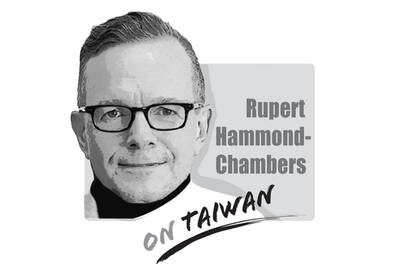The Dalai Lama is scheduled to leave today following a six-day visit comforting victims of Typhoon Morakot. The trip has provided a timely reminder of the increasing sway Beijing holds over many things, from the way the international media reports on certain subjects to Taiwanese politics and politicians.
One of the clearest examples of the former was the disproportionate amount of coverage given to a token number of pro-unification protesters who have followed the Nobel peace laureate.
Any neutral person watching or reading these reports from abroad may have received the impression that pro-China views are in the ascendancy in Taiwan, yet polls show that support for unification is less popular than even independence, at about 7 percent or 8 percent.
While this kind of trashy, low-cost reportage is understandable from certain sections of the domestic media, such protests would receive little or no attention in other countries. The activities of this rag-tag bunch received far more coverage than they deserved. One would expect the international press to do a better job.
While many international media groups reported on the protests, almost all neglected to mention the mandatory subtext to the story: Many of the demonstrations had been organized by a fugitive pro-unification gangster on the lam in China who once cooperated with the Chinese Nationalist Party (KMT) government to eliminate dissidents.
Time magazine even went so far as to describe the protests as “Taiwan’s raucous democracy,” a statement that deserves extensive qualification.
Taiwan’s relationship with China is an important issue that attracts news editors around the globe because of the dramatic headlines it provides, but editors shouldn’t let a good story get in the way of the truth. Some facts about the background of these protesters would have provided readers with a balanced story.
We also look forward to the day that the international press stops framing the Taiwan issue in Beijing’s terms.
Another inconvenient truth revealed by the visit is just how much the KMT and its politicians are in the pocket of Beijing. Not one KMT official or politician had the courage to meet the Dalai Lama — an all-too clear demonstration of where the party’s loyalties lie.
These elected representatives pandered to Beijing’s whims by shunning a figure idolized by the majority of the people he represents.
How the KMT can continue to claim to represent Taiwan when its first reaction on domestic issues is to solicit China’s advice is beyond comprehension.
But it’s not all bad news. One thing we can be thankful for, even in the face of reams of pro-China propaganda and falsehoods in the pro-unification media, is that the majority of Taiwanese are still able to recognize the Dalai Lama for what he is: a peace-loving religious leader who has been demonized by a malevolent, authoritarian power.
Who knows? Perhaps this clarity of judgment may soon extend to the KMT itself.
The gutting of Voice of America (VOA) and Radio Free Asia (RFA) by US President Donald Trump’s administration poses a serious threat to the global voice of freedom, particularly for those living under authoritarian regimes such as China. The US — hailed as the model of liberal democracy — has the moral responsibility to uphold the values it champions. In undermining these institutions, the US risks diminishing its “soft power,” a pivotal pillar of its global influence. VOA Tibetan and RFA Tibetan played an enormous role in promoting the strong image of the US in and outside Tibet. On VOA Tibetan,
Sung Chien-liang (宋建樑), the leader of the Chinese Nationalist Party’s (KMT) efforts to recall Democratic Progressive Party (DPP) Legislator Lee Kun-cheng (李坤城), caused a national outrage and drew diplomatic condemnation on Tuesday after he arrived at the New Taipei City District Prosecutors’ Office dressed in a Nazi uniform. Sung performed a Nazi salute and carried a copy of Adolf Hitler’s Mein Kampf as he arrived to be questioned over allegations of signature forgery in the recall petition. The KMT’s response to the incident has shown a striking lack of contrition and decency. Rather than apologizing and distancing itself from Sung’s actions,

US President Trump weighed into the state of America’s semiconductor manufacturing when he declared, “They [Taiwan] stole it from us. They took it from us, and I don’t blame them. I give them credit.” At a prior White House event President Trump hosted TSMC chairman C.C. Wei (魏哲家), head of the world’s largest and most advanced chip manufacturer, to announce a commitment to invest US$100 billion in America. The president then shifted his previously critical rhetoric on Taiwan and put off tariffs on its chips. Now we learn that the Trump Administration is conducting a “trade investigation” on semiconductors which
By now, most of Taiwan has heard Taipei Mayor Chiang Wan-an’s (蔣萬安) threats to initiate a vote of no confidence against the Cabinet. His rationale is that the Democratic Progressive Party (DPP)-led government’s investigation into alleged signature forgery in the Chinese Nationalist Party’s (KMT) recall campaign constitutes “political persecution.” I sincerely hope he goes through with it. The opposition currently holds a majority in the Legislative Yuan, so the initiation of a no-confidence motion and its passage should be entirely within reach. If Chiang truly believes that the government is overreaching, abusing its power and targeting political opponents — then